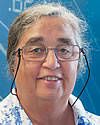 Lesley Wyborn |
2015 Contributions to Geoinformatics Award
Presented to Lesley Wyborn
Citation by Lee Allison
Dr Lesley Wyborn has built an international reputation for innovative leadership in geoinformatics and global e-research, particularly in the geoscience area. She is a tireless champion for building a strong and sustainable cohort of data scientists who are able to make use of the rapidly evolving computing technology and e-research infrastructure to help answer important geoscientific challenges. Dr Wyborn has also been an active participant in the international standards community, making significant contributions to the development of key international geoscience standards such as Geoscience Markup Language (GeoSciML) and has led the development and application of key Open Geospatial Consortium web services standards in Geoscience Australia.
The impact and influence of Dr Wyborn's work is substantial throughout her 40-year plus career, from her early more traditional geological field work based studies and findings in mineral systems, to her highly innovative international leadership in integrated geoscientific data management.
She has been hailed as “the most influential thought leader and practitioner in Australia in the field of cyber infrastructure,” with her work having tremendous impact across the geosciences and to other scientific domains and around the world. Among many other contributions, Lesley is the co-developer of the Australian Virtual Geophysics Laboratory (2012-2013), a novel workflow and processing approach which has not only had impact within the geophysics domain but has laid the groundwork for much broader application of these approaches across other geoscience, physical and broader environmental science domains.
Lesley is invariably gracious and generous in sharing – ideas, insights, and even her slides – to help support the community and move us forward. She is not only a technical leader in the world arena, but a facilitator, community-builder, and close friend to we who work in this burgeoning global community. I cannot state too strongly how much Lesley Wyborn deserves the recognition and honor of the Geoinformatics Career Achievement Award of the Geological Society of America.
 2015 Contributions to Geoinformatics Award — Response by Lesley Wyborn
2015 Contributions to Geoinformatics Award — Response by Lesley Wyborn
I am very honoured and extremely appreciative of the recognition this award confers and I would like to sincerely thank members of the Geoinformatics Division and the GSA: it is very humbling as an Australian to receive such an award from another country. However I cannot accept this award on my own, and would like to accept it on behalf of the many people I worked with in Geoscience Australia from 1972-2014 and more recently those at the National Computational Infrastructure (NCI) at the Australian National University.
I have only achieved this level of work in Geoinformatics through partnerships and collaborations with many international and national groups, and in particular, with colleagues from OneGeology, GeoSciML, Oceans Data Interoperability Platform (ODIP), International Geo Samples Number (IGSN), CSIRO and AuScope, and with funding support for many innovative informatics projects from the Australian Government National Collaboration Infrastructure Strategy (NCRIS).
In my 40+ year career I have seen many changes. I started as a field geologist in 1972 with paper notebooks, pencils and black and white aerial photographs (no GPS): data tables for publication were prepared on a manual typewriter. Now it is the age of the Internet with online digital data repositories that are coupled to research clouds and supercomputers. For data scientists their time finally has come, for it is the dawning of the fourth paradigm of data intensive science. Geoscientists can now take on research challenges at scales and resolutions never before possible.
I will always argue that my ability to contribute to the world of Geoinformatics was inspired by my early scientific training with my honors and PhD supervisors, the late Professors Tom Vallance and Bruce Chappell, who both instilled in me that science was about data and that “a true scientist is one whose data and conclusions can be independently verified”. In particular, Bruce would often say, “quantify your data and no one will argue with your science”.
As a working mother of 3 children under 4, I learned early on the power of sharing and collaboration: not only was it more efficient and effective, it also meant that any developments and learnings could be pooled. You also quickly realise that ideas from outside your own closed community were often better than your own. And through these many collaborations, I met the most incredible, dedicated and brilliant people who contributed to building the global Geoinformatics and compute infrastructures that we have today.
And now in the twilight of my career, I am privileged to be working on one of Australia’s peak computing facilities at NCI, with yet another generation of scientists. I have access to a 1.2 Petaflop supercomputer that is closely coupled with 10 PetaBytes of Earth and other research data. The opportunities for Geoscientists are phenomenal. But what is even more exciting is that multiple types of geoscience data are now on the same infrastructure as climate, marine, oceanographic, environmental, biological, social science, and medical science data: true, data intensive transdisciplinary science is now an achievable objective.
